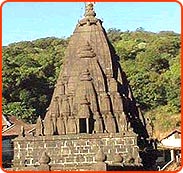 Bhimashankar Temple Jyotirlinga is situated in the ghat region of the Sahyadri hills in the village of Bhavagiri, 50-km north west of Khed, near Pune in Maharashtra. Bhima Shankar Temple lies on the banks of the river Bhima. Bhimashankar is also the source of the river Bhima, which flows southeast and merges with the Krishna River near Raichur. The other Jyotirlinga shrines in Maharashtra are Tryambakeshwar and Grishneshwar. It may be noted that according to the Shiv Purana the Bhimashankar Jyotirlinga is situated on the Mountain Brahmapur in district Kamrup, Assam.
Bhimashankar Temple Jyotirlinga is situated in the ghat region of the Sahyadri hills in the village of Bhavagiri, 50-km north west of Khed, near Pune in Maharashtra. Bhima Shankar Temple lies on the banks of the river Bhima. Bhimashankar is also the source of the river Bhima, which flows southeast and merges with the Krishna River near Raichur. The other Jyotirlinga shrines in Maharashtra are Tryambakeshwar and Grishneshwar. It may be noted that according to the Shiv Purana the Bhimashankar Jyotirlinga is situated on the Mountain Brahmapur in district Kamrup, Assam.Legend behind Bhimashankar Temple
According to the legends, once a demon called Bhima lived with his mother Karkati in the dense forests of Dakini, on the lofty ranges of the Sahaydris. It is said that Bhima was so cruel that every one was scared of him. But what tormented Bhima was his curiosity regarding his own existence. One day, Bhima urged his mother to tell him who his father was and why had he abandoned them in the wilderness of the forest. His mother revealed that he was the son of Kumbhakarna, the younger brother of the mighty King Ravana - the King of Lanka. Bhima’s mother Kartaki also told him that Lord Vishnu in his incarnation as Lord Rama annihilated Kumbhakarna. This infuriated Bhima and he vowed to avenge Lord Vishnu.
Bhima performed severe penance to please Lord Brahma. The compassionate creator was pleased by the dedicated devotee and granted him immense prowess. With so much power, Bhima began to cause havoc in the three worlds. He defeated King Indra and conquered the heavens. He also defeated a staunch devotee of Lord Shiva - Kamrupeshwar and put him in the dungeons. All this angered the Gods and they along with Lord Brahma beseeched Lord Shiva to come for their rescue to which Lord Shiva agreed.
Tyrant Bhima asked Kamrupeshwar to worship him instead of Lord Shiva. When Kamrupeshwar refused, Bhima raised his sword to strike the Shiva Linga. But as soon as he raised his sword, Lord Shiva appeared before him in full magnificence. Then the terrible war began. Holy sage Narad appeared and requested Lord Shiva to put an end to this war. It was then that Lord Shiva reduced the evil demon to ashes and thus concluded the saga of tyranny. All the Gods and the holy sages present there requested Lord Shiva to make this place his abode. Lord Shiva thus manifested himself in the form of the Bhimashankar Jyotirlinga. It is believed that the sweat that poured forth from Lord Shiva’s body after the battle formed the Bhimarathi River.
Structure of Bhimashankara Temple
Bhimashankara Temple is situated in picturesque extreme end of the Sahayadri Ranges and provides a wonderful view of the forts, the rivers and the hill stations around. The dense forests surrounding the high ranges also play an abode to the rare species of flora and fauna.
Bhimashakara Temple dates back to mid 18th century and is a composite of old and the new structures and is built in the Nagara style of architecture. The shikhara of the temple was built by Nana Phadnavis. Shivaji - the great Maratha ruler is said to have facilitated the carrying out of worship services. As with other Shiva temples in this area, the sanctum is at a lower level. The best time to visit the Bhimashankar Temple is said to be Maha Shivaratri as the temple organizes grand festivities on the occasion.












0 comments:
Post a Comment